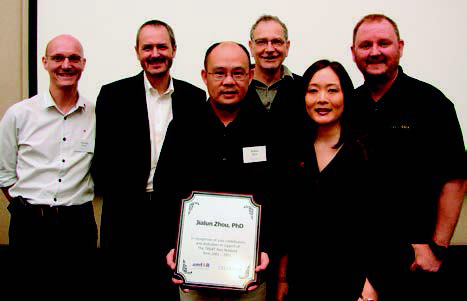In 2003, The TREAT Asia HIV Observational Database (TAHOD) became the first study to collect treatment data from clinical sites throughout the Asia-Pacific
In the early 2000s, access to antiretroviral therapy (ART) began rapidly expanding in developing countries across the Asia-Pacific region. However, at the time very little information existed about patients taking ART in Asia—a region that is home to more than 60% of the world’s population and nearly five million HIV-positive people. Asia has different HIV risk groups and prevalent viral subtypes than other regions. Additionally, Asian populations differ genetically and physiologically from other populations, and the region has high rates of HIV co-infection with hepatitis B and C and tuberculosis. All of which prompted many unanswered questions about how best to treat HIV.

Previous and current members of the TAHOD leadership
team: (left to right) Nicolas Durier M.D., M.P.H., Matthew
Law, Ph.D., Jialun Zhou, Ph.D., David Cooper, M.D.,
D.Sc., Annette Sohn, M.D., and Kevin Robert Frost.
“At that time, there were some real concerns that ART outcomes could be considerably different than in treated populations in developed countries,” says Matthew Law, Ph.D., head of the Biostatistics and Databases Program at the Kirby Institute for infection and immunity in society at the University of New South Wales, Australia, which serves as the data management and biostatistics center for TAHOD.
In September 2003, TREAT Asia launched TAHOD to pool data from Asian clinical sites and better understand treatment outcomes in HIV-positive patients. TAHOD was the first database of its kind in the region. When it started, the database included 11 clinics and hospitals reporting data on nearly 2,000 HIV-positive adult patients. Today, it has grown to include 19 sites in 12 countries, and contains data from 8,000 patients. “The AIDS epidemic was slower in coming to much of Asia than to some other areas of the world, but it has spread to every part of the continent,” says Kevin Robert Frost, CEO of amfAR. “TREAT Asia and TAHOD are linking countries to provide a truly collaborative and regional response to this growing epidemic.”
In May 2004, TAHOD completed its first analysis, concluding that “HIV and its treatment are not in fact radically different in Asia,” says Law. “This finding filled in many data gaps and addressed concerns that were current in the early 2000s, and provided a solid base for future HIV policy and practice in the region.”

Participants at the 10th TREAT Asia Network Annual Meeting in Tabanan, Bali, in 2010.
In 2006, TAHOD was able to further expand the scope of its research when the U.S. National Institute of Allergy and Infectious Diseases (NIAID) selected TREAT Asia and Principal Investigator David Cooper, M.D., Director of the Kirby Institute, to lead the Asia-Pacific component of the International Epidemiologic Databases to Evaluate AIDS (IeDEA) consortium. This included an initial five-year grant of $6.1 million, which was later renewed until 2016. TREAT Asia now contributes its data to global analyses of the HIV epidemic conducted in partnership with IeDEA regional partners in Africa and North and South America.
Over the last 10 years, network investigators have published almost 40 analyses of TAHOD data in peer- reviewed medical journals, creating a unique evidence base to support our understanding of regional HIV trends. Collaborations through IeDEA multi-regional analyses have a similar impact on global HIV epidemiology. For example, a paper accepted for publication in the Journal of Acquired Immune Deficiency Syndromes will report that while the average CD4 count of patients starting HIV therapy in developing countries increased over the previous decade, it remained below 200 cells/mm3, a threshold associated with severe immune suppression. Even with the recent scale-up of treatment access, patients in these regions are still not initiating treatment until after their disease has already progressed.
After 10 years of epidemiologic research, many important questions remain unanswered. “We’re only 10 years into effective HIV treatment in developing countries in Asia, and less than 20 worldwide, and the full scope of the longer-term impact of ART remains unknown,” says Law. “Also, developing countries don’t have the same range of ART options as developed countries. As growing numbers of people fail first- and second-line regimens, it will be even more important to monitor patient outcomes through programs like TAHOD.”
